Effect of Carbon on Dislocation Loops Formation during Self-Ion Irradiation in Fe-Cr Alloys at High Temperatures
Abstract
:1. Introduction
2. Materials and Experimental Procedure
2.1. Materials
2.2. Irradiation Experiments
2.3. TEM Sample Preparation and Characterization
3. Results and Discussion
3.1. Microstructure of Unirradiated Fe-Cr Alloys
3.2. Microstructure of Fe-Cr Alloys after Irradiation at 450 °C
3.3. Microstructure of Fe−Cr Alloys after Irradiation at 550 °C
3.4. The Formation of Subgrains
4. Conclusions
Author Contributions
Funding
Institutional Review Board Statement
Informed Consent Statement
Data Availability Statement
Acknowledgments
Conflicts of Interest
References
- Klueh, R.L.; Gelles, D.S.; Jitsukawa, S.; Kimura, A.; Odette, G.R.; van der Schaaf, B.; Victoria, M. Ferritic/martensitic steels—Overview of recent results. J. Nucl. Mater. 2002, 307–311, 455–465. [Google Scholar] [CrossRef]
- Blasl, D.; Tsunakawa, H.; Miyahara, K.; Igata, N. Void swelling and microstructure evolution of a dual phase (ferritic and austenitic) stainless steel. J. Nucl. Mater. 1985, 133–134, 517–520. [Google Scholar] [CrossRef]
- Yvon, P.; Carré, F. Structural materials challenges for advanced reactor systems. J. Nucl. Mater. 2009, 385, 217–222. [Google Scholar] [CrossRef]
- Ehrlich, K. Materials research towards a fusion reactor. Fusion Eng. Des. 2001, 56–57, 71–82. [Google Scholar] [CrossRef]
- Yao, Z.; Hernandez-Mayoral, M.; Jenkins, M.L.; Kirk, M.A. Heavy-ion irradiations of Fe and Fe-Cr model alloys Part 1: Damage evolution in thin-foils at lower doses. Phil. Mag. 2008, 88, 2851–2880. [Google Scholar] [CrossRef] [Green Version]
- Bachhav, M.; Odette, G.R.; Marquis, E.A. α′ precipitation in neutron-irradiated Fe-Cr alloys. Scr. Mater. 2014, 74, 48–51. [Google Scholar] [CrossRef]
- Kuksenko, V.; Pareige, C.; Pareige, P. Cr precipitation in neutron irradiated industrial purity Fe-Cr model alloys. J. Nucl. Mater. 2013, 432, 160–165. [Google Scholar] [CrossRef]
- Getto, E.; Sun, K.; Monterrosa, A.M.; Jiao, Z.; Hackett, M.J.; Was, G.S. Void swelling and microstructure evolution at very high damage level in self-ion irradiated ferritic-martensitic steels. J. Nucl. Mater. 2016, 480, 159–176. [Google Scholar] [CrossRef]
- Bhattacharya, A.; Meslin, E.; Henry, J.; Barbu, A.; Poissonnet, S.; Décamps, B. Effect of chromium on void swelling in ion irradiated high purity Fe-Cr alloys. Acta Mater. 2016, 108, 241–251. [Google Scholar] [CrossRef] [Green Version]
- Terentyev, D.; Bergner, F.; Osetsky, Y. Cr segregation on dislocation loops enhances hardening in ferritic Fe-Cr alloys. Acta Mater. 2013, 61, 1444–1453. [Google Scholar] [CrossRef]
- Bhattacharya, A.; Meslin, E.; Henry, J.; Pareige, C.; Décamps, B.; Genevois, C.; Brimbal, D.; Barbu, A. Chromium enrichment on the habit plane of dislocation loops in ion-irradiated high-purity Fe-Cr alloys. Acta Mater. 2014, 78, 394–403. [Google Scholar] [CrossRef]
- Arakawa, K.; Hatanaka, M.; Mori, H.; Ono, K. Effects of chromium on the one-dimensional motion of interstitial-type dislocation loops in iron. J. Nucl. Mater. 2004, 329–333, 1194–1198. [Google Scholar] [CrossRef]
- Hernández-Mayoral, M.; Heintze, C.; Oñorbe, E. Transmission electron microscopy investigation of the microstructure of Fe-Cr alloys induced by neutron and ion irradiation at 300 °C. J. Nucl. Mater. 2016, 474, 88–98. [Google Scholar] [CrossRef]
- Xu, S.; Yao, Z.; Jenkins, M.L. TEM characterisation of heavy-ion irradiation damage in FeCr alloys. J. Nucl. Mater. 2009, 386–388, 161–164. [Google Scholar] [CrossRef]
- Schäublin, R.; Décamps, B.; Prokhodtseva, A.; Löffler, J.F. On the origin of the primary ½ a0 <111> and a0 <100> loops in irradiated Fe (Cr) alloys. Acta Mater. 2017, 133, 427–439. [Google Scholar] [CrossRef]
- Matijasevic, M.; Almazouzi, A. Effect of Cr on the mechanical properties and microstructure of Fe-Cr model alloys after n-irradiation. J. Nucl. Mater. 2008, 377, 147–154. [Google Scholar] [CrossRef]
- Porollo, S.I.; Dvoriashin, A.M.; Vorobyev, A.N.; Konobeev, Y.V. The microstructure and tensile properties of Fe-Cr alloys after neutron irradiation at 400 °C to 5.5-7.1 dpa. J. Nucl. Mater. 1998, 256, 247–253. [Google Scholar] [CrossRef]
- Domain, C.; Becquart, C.S.; Foct, J. Ab initio study of foreign interstitial atom (C, N) interactions with intrinsic point defects in α-Fe. Phys. Rev. B-Condens. Matter Mater. Phys. 2004, 69, 1–16. [Google Scholar] [CrossRef]
- Terentyev, D.; Anento, N.; Serra, A.; Jansson, V.; Khater, H.; Bonny, G. Interaction of carbon with vacancy and self-interstitial atom clusters in α-iron studied using metallic-covalent interatomic potential. J. Nucl. Mater. 2011, 408, 272–284. [Google Scholar] [CrossRef]
- Terentyev, D.; Martin-Bragado, I. Evolution of dislocation loops in iron under irradiation: The impact of carbon. Scr. Mater. 2015, 97, 5–8. [Google Scholar] [CrossRef]
- Druzhkov, A.P.; Nikolaev, A.L. Effects of solute atoms on evolution of vacancy defects in electron-irradiated Fe-Cr-based alloys. J. Nucl. Mater. 2011, 408, 194–200. [Google Scholar] [CrossRef]
- Konstantinović, M.J.; van Renterghem, W.; Matijašević, M.; Minov, B.; Lambrecht, M.; Toyama, T.; Chiapetto, M.; Malerba, L. Mechanical and microstructural properties of neutron irradiated Fe-Cr-C alloys. Phys. Status Solidi Appl. Mater. Sci. 2016, 213, 2988–2994. [Google Scholar] [CrossRef]
- Was, G.S. Fundamentals of Radiation Materials Science: Metals and Alloys; Springer: Berlin/Heidelberg, Germany, 2007; p. 88. [Google Scholar]
- Lu, C.; Jin, K.; Béland, L.K.; Zhang, F.; Yang, T.; Qiao, L.; Zhang, Y.; Bei, H.; Christen, H.M.; Stoller, R.E.; et al. Direct Observation of Defect Range and Evolution in Ion-Irradiated Single Crystalline Ni and Ni Binary Alloys. Sci. Rep. 2016, 6, 1–10. [Google Scholar] [CrossRef] [Green Version]
- Dudarev, S.L.; Boutard, J.L.; Lässer, R.; Caturla, M.J.; Derlet, P.M.; Fivel, M.; Fu, C.C.; Lavrentiev, M.Y.; Malerba, L.; Mrovec, M.; et al. The EU programme for modelling radiation effects in fusion reactor materials: An overview of recent advances and future goals. J. Nucl. Mater. 2009, 386–388, 1–7. [Google Scholar] [CrossRef]
- Tapasa, K.; Barashev, A.V.; Bacon, D.J.; Osetsky, Y.N. Computer simulation of carbon diffusion and vacancy-carbon interaction in α-iron. Acta Mater. 2007, 55, 1–11. [Google Scholar] [CrossRef]
- Anento, N.; Serra, A. Carbon-vacancy complexes as traps for self-interstitial clusters in Fe-C alloys. J. Nucl. Mater. 2013, 440, 236–242. [Google Scholar] [CrossRef]
- Jansson, V.; Chiapetto, M.; Malerba, L. The nanostructure evolution in Fe-C systems under irradiation at 560 K. J. Nucl. Mater. 2013, 442, 341–349. [Google Scholar] [CrossRef] [Green Version]
- Jansson, V.; Malerba, L. Simulation of the nanostructure evolution under irradiation in Fe-C alloys. J. Nucl. Mater. 2013, 443, 274–285. [Google Scholar] [CrossRef] [Green Version]
- Konstantinović, M.J.; Malerba, L. Dissolution of carbon-vacancy complexes in Fe-C alloys. Phys. Rev. Mater. 2017, 1, 1–6. [Google Scholar] [CrossRef]
- Duparc, A.H.; Moingeon, C.; Smetniansky-De-Grande, N.; Barbu, A. Microstructure modelling of ferritic alloys under high flux 1 MeV electron irradiations. J. Nucl. Mater. 2002, 302, 143–155. [Google Scholar] [CrossRef]
- Li, Y.; Hu, S.; Henager, C.H.; Deng, H.; Gao, F.; Sun, X.; Khaleel, M.A. Computer simulations of interstitial loop growth kinetics in irradiated bcc Fe. J. Nucl. Mater. 2012, 427, 259–267. [Google Scholar] [CrossRef]
- Tapasa, K.; Barashev, A.V.; Bacon, D.J.; Osetsky, Y.N. Computer simulation of the interaction of carbon atoms with self-interstitial clusters in α-iron. J. Nucl. Mater. 2007, 361, 52–61. [Google Scholar] [CrossRef]
- Lin, Y.R.; Chen, W.Y.; Li, M.; Henry, J.; Zinkle, S.J. Dynamic observation of dual-beam irradiated Fe and Fe-10Cr alloys at 435 °C. Acta Mater. 2021, 209, 116793. [Google Scholar] [CrossRef]
- Horton, L.L.; Bentley, J.; Jesser, W.A. The microstructure of triple-beam ion irradiated Fe and Fe-Cr alloys. J. Nucl. Mater. 1981, 104, 1085–1089. [Google Scholar] [CrossRef] [Green Version]
- Horton, L.L.; Bentley, J.; Farrell, K. A TEM study of neutron-irradiated iron. J. Nucl. Mater. 1982, 108–109, 222–233. [Google Scholar] [CrossRef] [Green Version]
- Nesterova, E.V.; Rybin, V.V.; Zinkle, S.J.; Barabash, V.R.; Naberenkov, A.V. Ion irradiation induced subgrain structure formation in dispersion strengthened copper alloys. Plasma Devices Oper. 1994, 2, 293–300. [Google Scholar] [CrossRef]
- Zheng, R.Y.; Han, W.Z. Comparative study of radiation defects in ion irradiated bulk and thin-foil tungsten. Acta Mater. 2020, 186, 162–171. [Google Scholar] [CrossRef]
- Lin, Y.R.; Bhattacharya, A.; Chen, D.; Kai, J.J.; Henry, J.; Zinkle, S.J. Temperature-dependent cavity swelling in dual-ion irradiated Fe and Fe-Cr ferritic alloys. Acta Mater. 2021, 207, 116660. [Google Scholar] [CrossRef]
- Hull, D.; Bacon, D.J. Introduction to Dislocations; Elsevier: Liverpool, UK, 2011; p. 203. [Google Scholar] [CrossRef]
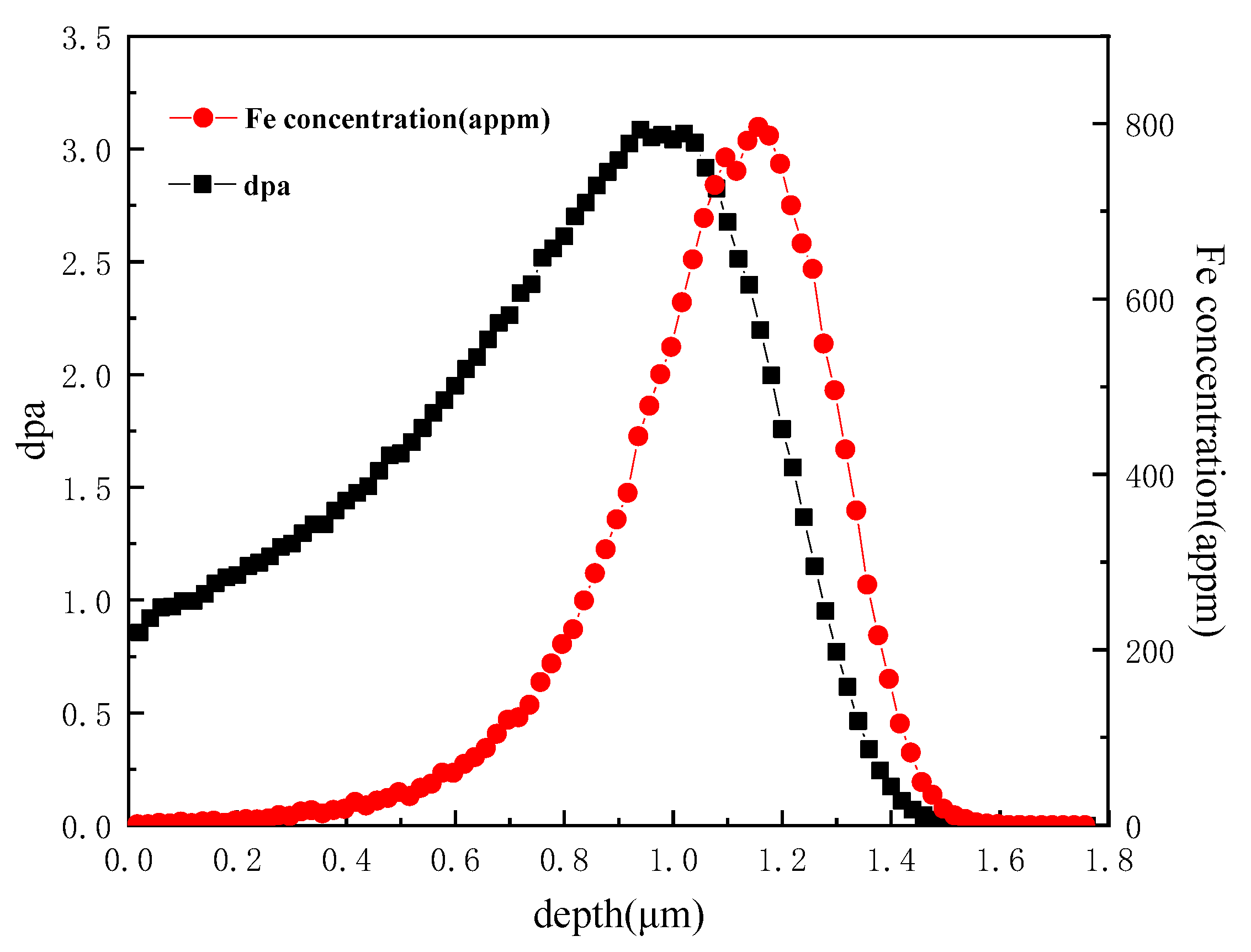
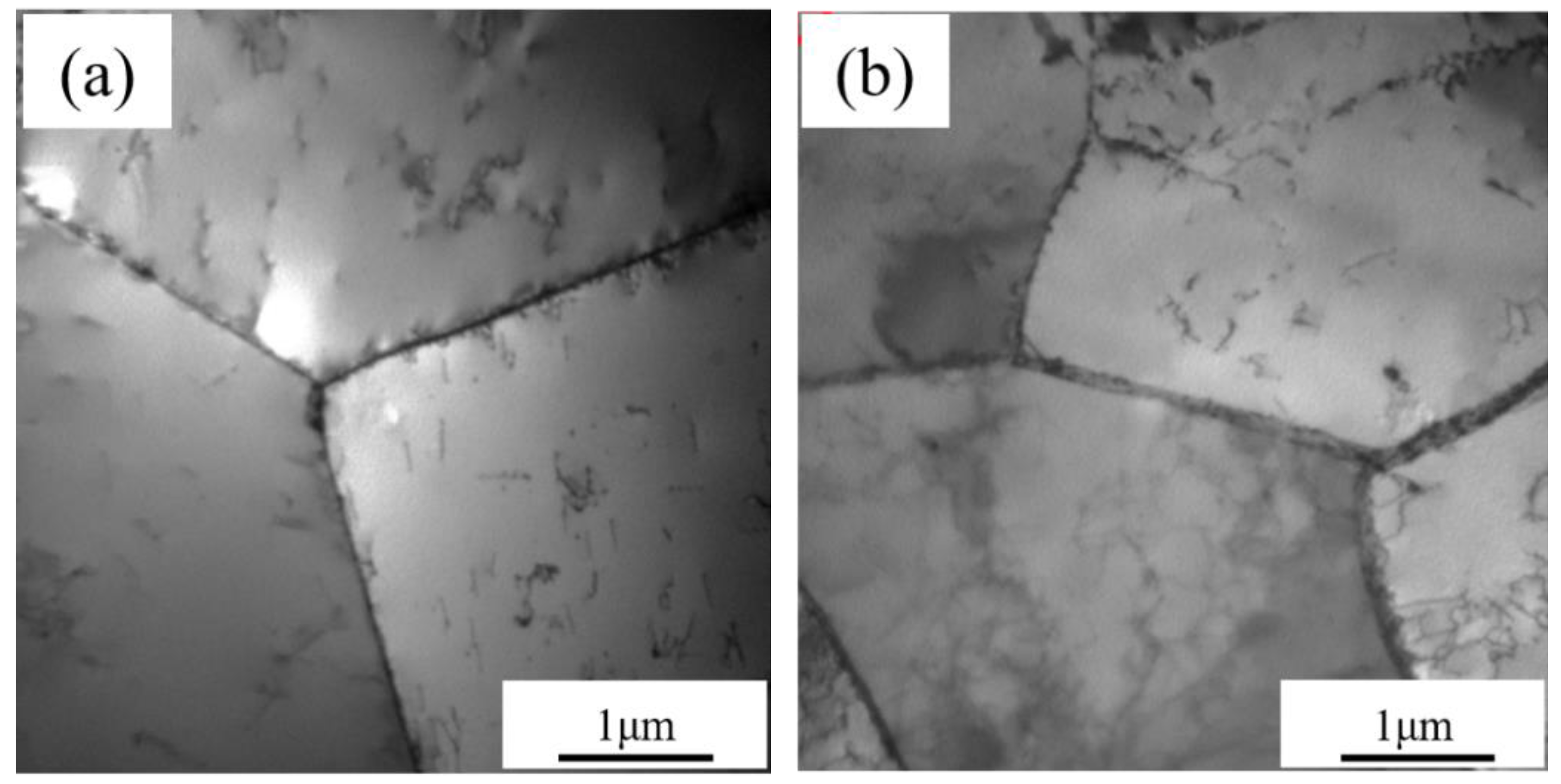
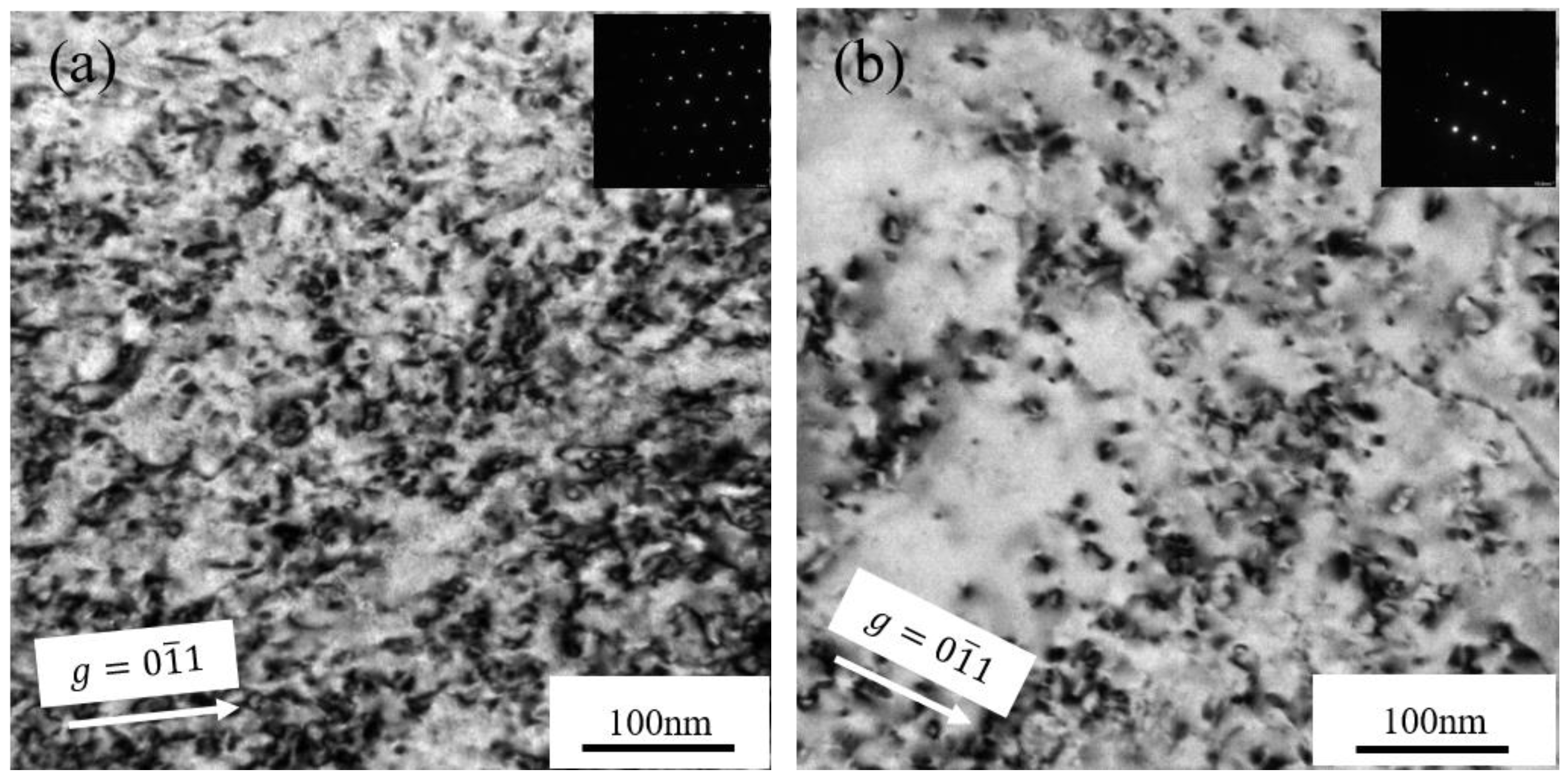
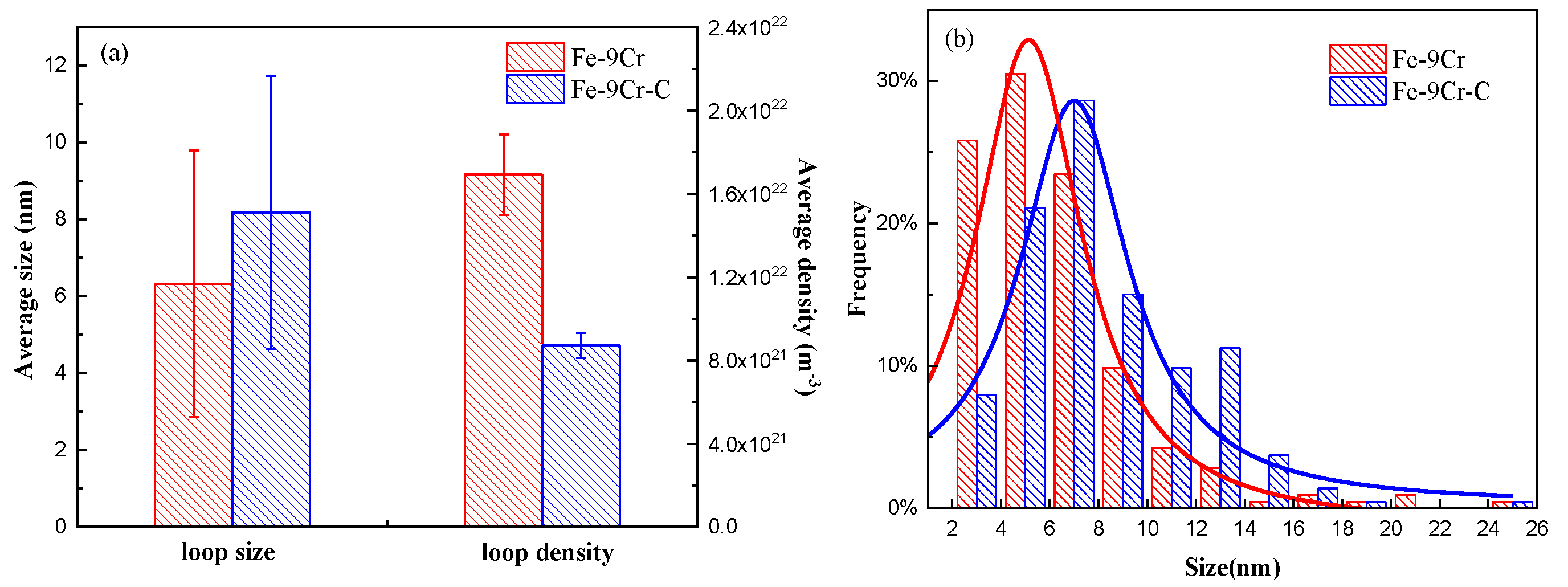
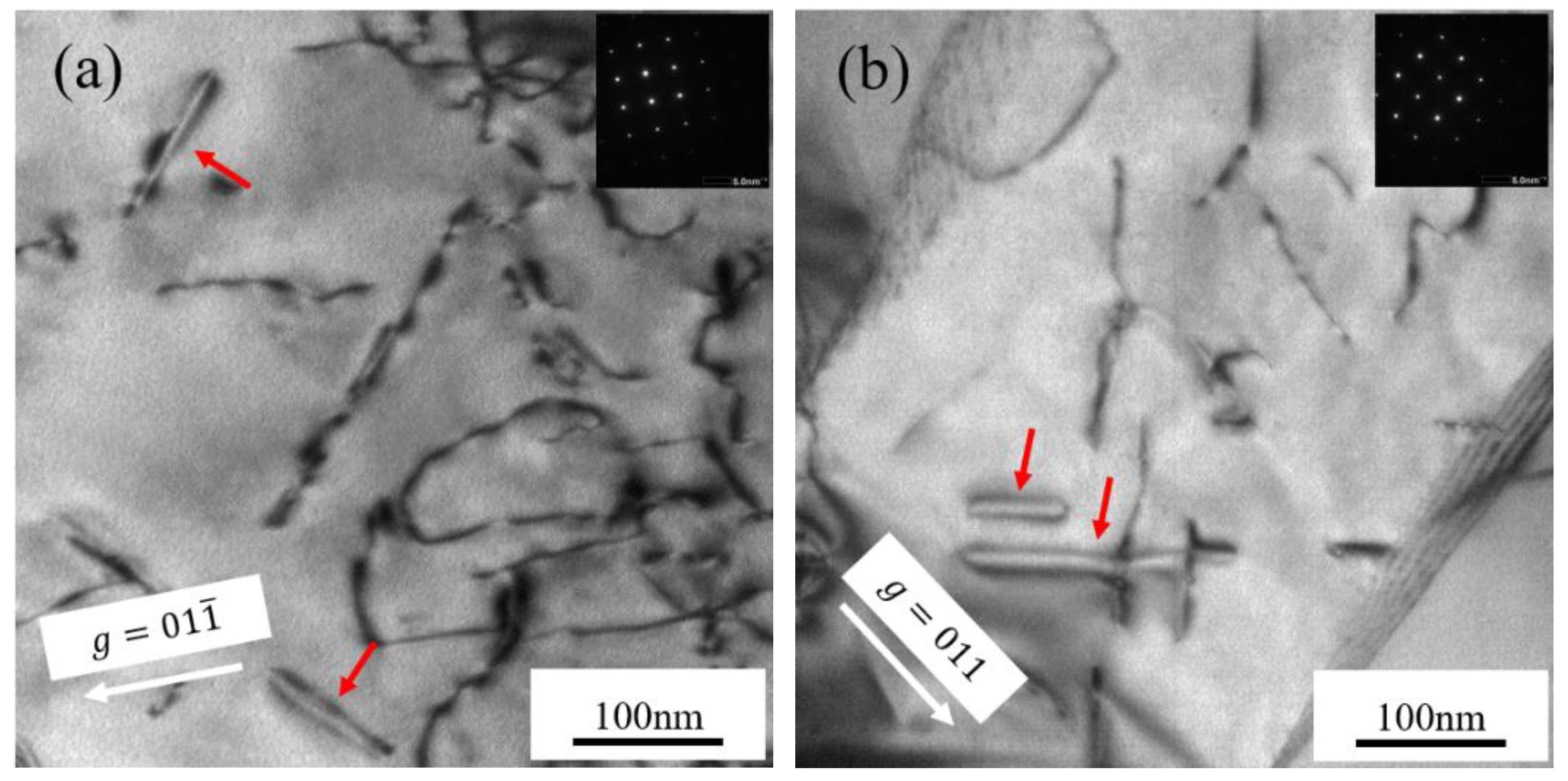

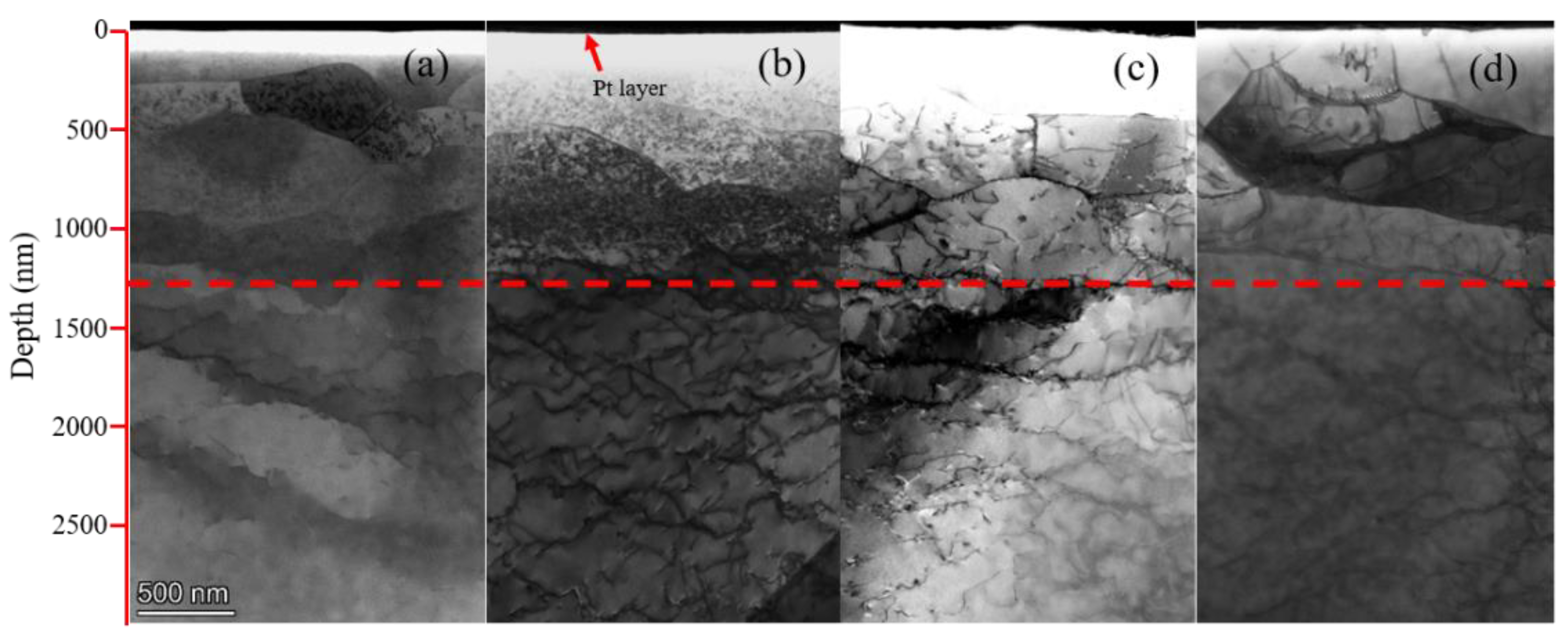
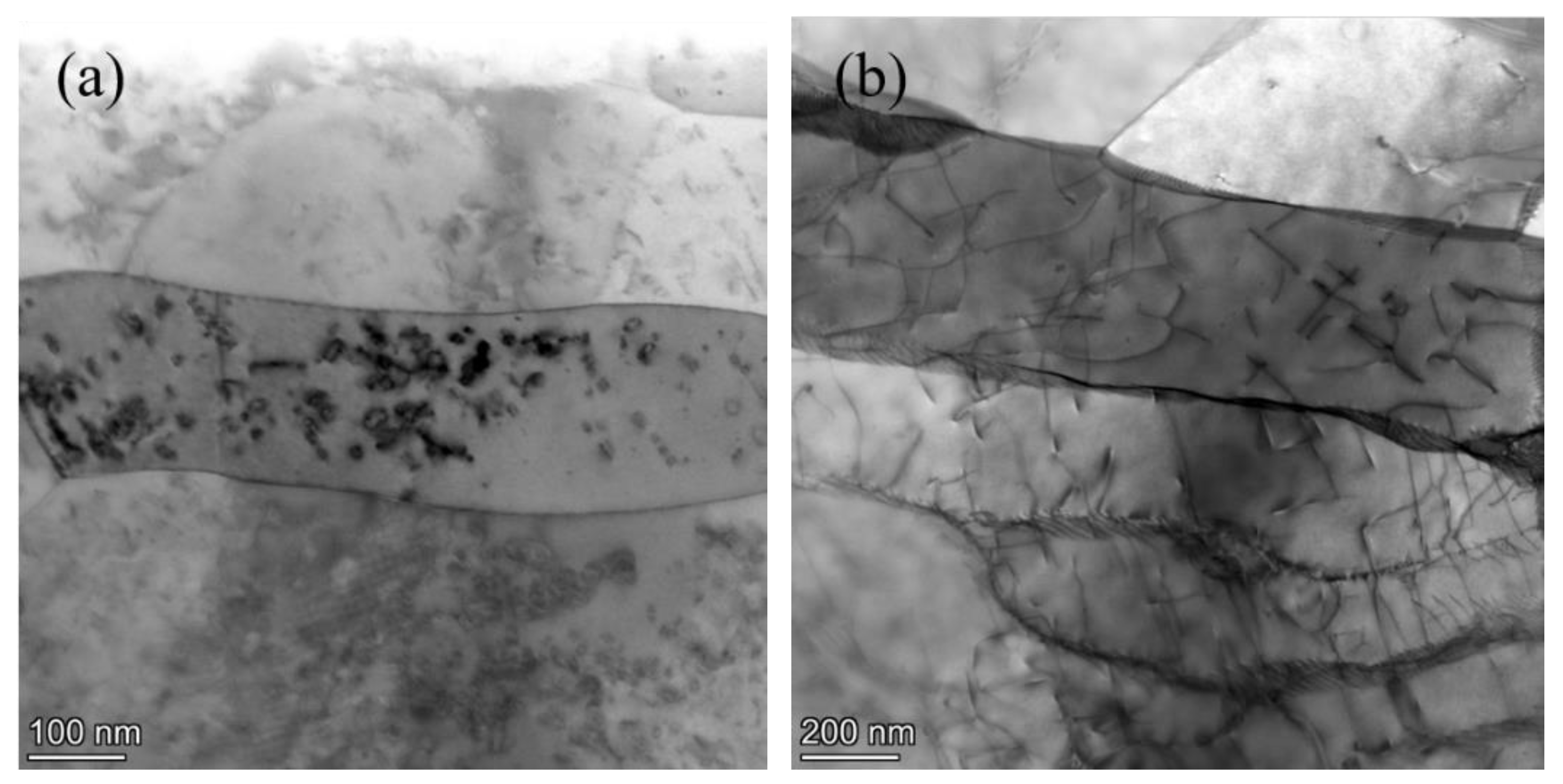
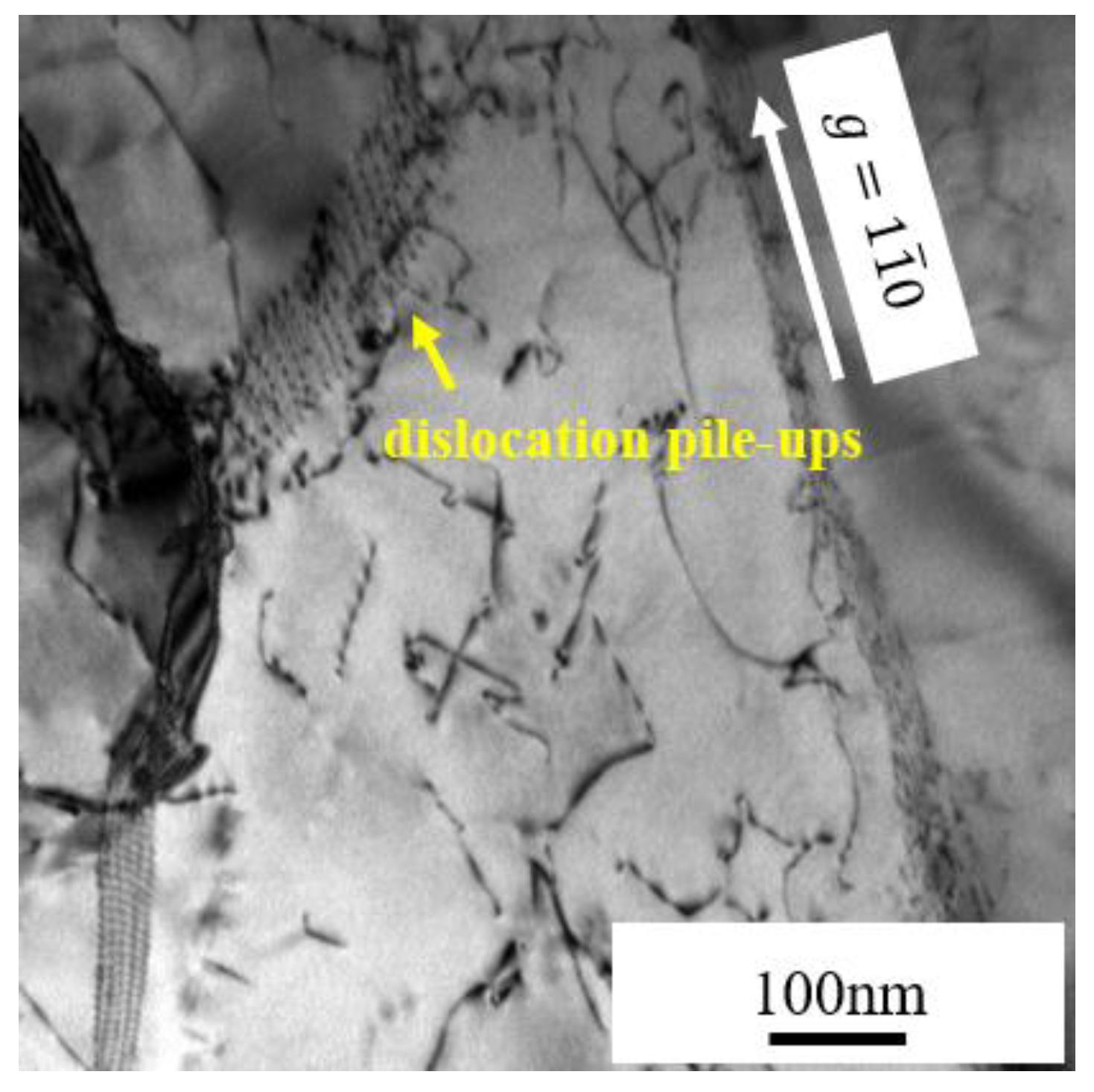
| Alloy | Cr | C | N | O | P | S |
|---|---|---|---|---|---|---|
| Fe-9Cr | 8.97 | 0.003 | 0.0014 | 0.013 | 0.0074 | <0.003 |
| Fe-9Cr-C | 8.90 | 0.012 | 0.0043 | 0.027 | 0.0076 | <0.003 |
| Alloy | Temperature (°C) | Dose at Peak (dpa) | Dose Rate (dpa/s) |
|---|---|---|---|
| Fe-9Cr | 450 | 3 | 1.7 × 10−4 |
| Fe-9Cr-C | 450 | 3 | 1.7 × 10−4 |
| Fe-9Cr | 550 | 3 | 1.3 × 10−4 |
| Fe-9Cr-C | 550 | 3 | 1.3 × 10−4 |
| Alloy | Average Size (nm) (Number of Loops Measured) | Average Density (×1021 m−3) |
|---|---|---|
| Fe-9Cr (at 450 °C) | 6.3 ± 3.5 (213) | 16.9 ± 1.9 |
| Fe-9Cr-C (at 450 °C) | 8.2 ± 3.5 (213) | 8.7 ± 0.6 |
| Fe-9Cr (at 550 °C) | 32.5 ± 28.9 (15) | Not measured |
| Fe-9Cr-C (at 550 °C) | 47.8 ± 35.0 (12) | Not measured |
Publisher’s Note: MDPI stays neutral with regard to jurisdictional claims in published maps and institutional affiliations. |
© 2022 by the authors. Licensee MDPI, Basel, Switzerland. This article is an open access article distributed under the terms and conditions of the Creative Commons Attribution (CC BY) license (https://creativecommons.org/licenses/by/4.0/).
Share and Cite
Shi, T.; Liu, W.; Su, Z.; Yan, X.; Lu, C.; Yun, D. Effect of Carbon on Dislocation Loops Formation during Self-Ion Irradiation in Fe-Cr Alloys at High Temperatures. Materials 2022, 15, 2211. https://doi.org/10.3390/ma15062211
Shi T, Liu W, Su Z, Yan X, Lu C, Yun D. Effect of Carbon on Dislocation Loops Formation during Self-Ion Irradiation in Fe-Cr Alloys at High Temperatures. Materials. 2022; 15(6):2211. https://doi.org/10.3390/ma15062211
Chicago/Turabian StyleShi, Tiantian, Wenbo Liu, Zhengxiong Su, Xu Yan, Chenyang Lu, and Di Yun. 2022. "Effect of Carbon on Dislocation Loops Formation during Self-Ion Irradiation in Fe-Cr Alloys at High Temperatures" Materials 15, no. 6: 2211. https://doi.org/10.3390/ma15062211
APA StyleShi, T., Liu, W., Su, Z., Yan, X., Lu, C., & Yun, D. (2022). Effect of Carbon on Dislocation Loops Formation during Self-Ion Irradiation in Fe-Cr Alloys at High Temperatures. Materials, 15(6), 2211. https://doi.org/10.3390/ma15062211






